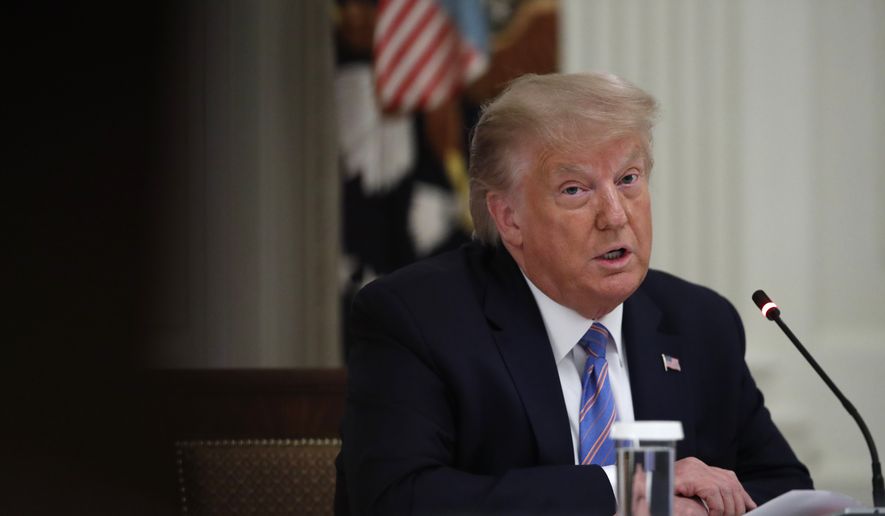President Trump on Tuesday declared that K-12 schools should move full steam ahead toward reopening in the fall despite concerns from local leaders and education groups about exposing students and teachers to the coronavirus.
Mr. Trump and other administration officials said schools districts should make every effort to get in-person classes back up and fully running for the next academic year, which would be as soon as next month for many.
The president said “no way” to local leaders who proposed to keep schools closed. He described it as an effort to damage him politically before the November election.
“We’re very much going to put pressure on governors and everybody else to open the schools,” the president said at a White House event with educators. “It’s very important for the well-being of the student and the parents.”
Parents across the country who spent much of the spring juggling work-from-home with looking after their children are now staring at additional weeks and potentially months of trying to engage in the increasingly untenable balancing act.
The White House was pushing to reopen schools as states across the South and West were dealing with spikes in COVID-19 cases.
A resurgence of COVID-19 cases in Texas prompted El Paso Mayor Dee Margo to weigh plans for delaying the start of the school year until after Labor Day.
Officials in school districts across the country are holding similar discussions as the nation records almost 3 million cases and more than 130,000 deaths from COVID-19, the disease caused by the coronavirus.
Dr. Robert R. Redfield, director of the Centers for Disease Control and Prevention, said the CDC is encouraging all schools “to do what they need to reopen.”
He called schools a “vital part of our society.”
“We think as you measure the different risk, it’s clear that we would see the greater risk to our society as to have these schools closed,” Dr. Redfield said.
The American Academy of Pediatrics recently underscored the importance of in-person learning. It said school closures this spring produced adverse outcomes, including developmental and emotional consequences associated with social isolation.
The group “strongly advocates that all policy considerations for the upcoming school year should start with a goal of having students physically present in school,” according to guidance from the academy.
House Minority Leader Kevin McCarthy, California Republican, said Congress has an opportunity to address the “looming crisis” of schools and child care in the next coronavirus relief bill.
“We cannot let our focus on the present distract us from preventing a child care crisis that will keep our students from returning to the classroom and their parents from returning to their workplace,” Mr. McCarthy said in an opinion piece for USA Today.
Whenever the doors open, many schools are preparing social distancing rules that will give students a much different experience in the classrooms, hallways and lunchrooms.
Kellyanne Conway, counselor to the president, floated ideas including having students eat lunch at their desks, curbing bus services and introducing staggered classes at reduced capacity.
“No more cupcake parties. Maybe no field trips,” she said. “So things will feel differently.”
The White House emphasized that even as the number of daily COVID-19 cases in the country has surged past 50,000 in recent weeks, the trend for death rates is moving in the right direction.
Dr. Anthony Fauci, the administration’s top infectious diseases expert, said the country can’t get complacent at such a crucial time.
“It’s a false narrative to take comfort in a lower rate of death,” said Dr. Fauci, director of the National Institute of Allergy and Infectious Diseases. “There [are] so many other things that are very dangerous and bad about this virus. Don’t get yourself into false complacency.”
Colleges and universities also are grappling with how to proceed.
Harvard University announced plans this week to bring up to 40% of undergraduates, including all first-year students, to campus in the fall, but said all undergraduate and graduate course instruction for the academic year will be conducted online.
Mr. Trump called Harvard’s approach “ridiculous.”
“I think it’s an easy way out, and I think they ought to be ashamed of themselves,” he said.
The University System of Georgia announced that students, faculty and staff have to wear masks starting July 15 when they are indoors.
Meanwhile, several companies on Tuesday announced progress on testing and a potential vaccine and treatments.
Novavax said it won a $1.6 billion grant from the federal government to move forward with a “late stage” clinical development, including a phase three clinical trial.
The company said it potentially could deliver 100 million doses of its vaccine candidate by the end of the year.
Regeneron Pharmaceuticals announced that it won a $450 million contract to develop an antibody “cocktail” intended to treat and/or prevent COVID-19.
Both contracts are part of the Trump administration’s Operation Warp Speed, an initiative intended to help produce a widely available vaccine for the coronavirus by the end of the year.
LabCorp announced a home collection service that will enable doctors to order nasal swab kits for their patients, who can then send the test back to the testing company.
The results would be uploaded to a patient portal to allow doctors to decide the next steps.
While some health experts, including Dr. Fauci, have said a vaccine could be readily available by the end of the year, others are preaching caution.
“If we’re really lucky, three years,” said Dean Hart, a microbiology expert who has written on virus transmissions.
• Dave Boyer can be reached at dboyer@washingtontimes.com.
• David Sherfinski can be reached at dsherfinski@washingtontimes.com.




Please read our comment policy before commenting.